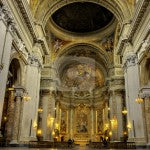By the time the Renaissance had ended, the Catholic Church proposed a course of action. This action was the Counter-Reformation. It was to restore the faith of those shaken by Protestant reformers. From there, the Baroque architectural movement started.
Although the movement had begun during the late 16th century, it was in the 17th century that it flourished. Through religious influences, Baroque church architecture began to spread throughout Europe.
Below are features of Baroque architecture.
Naves
 Image source: Cutcaster
Image source: Cutcaster
Broader, more robust naves which appeared circular replaced the narrower ones. Though the naves seemed stronger, they prohibited towering roofs and spires.
Dramatic lighting
 Image source: La Galerie de Photo GoCarlo
Image source: La Galerie de Photo GoCarlo
The use of light and dark elements in both Baroque art and architecture were evident in churches. A sort of contrasting ambience dominated church interiors, used to dramatic effect.
Use of ornaments and art
 Image source: Dreamstime
Image source: Dreamstime
Baroque churches were often well-adorned with ornaments which many would find beautiful or fascinating. This was to attract people to the faith. Furthermore, statues would be inside churches with the intent of educating people.
Façade with central projection
 Image source: Not Quite Marco Polo
Image source: Not Quite Marco Polo
Church facades during the Baroque era focused on the center of the building, giving one an idea on what the interior looks like.
Examples of Baroque Architecture
Karlskirche, Vienna (1716-1737 AD)
 Image source: Karlskirche
Image source: Karlskirche
St. Paul’s Cathedral, London (1710 AD)
 Image source: St Dunstan and All Saints Stepney
Image source: St Dunstan and All Saints Stepney
San Carlo alle Quattro Fontane, Rome (1638 AD)
 Image source: Bluffton.edu
Image source: Bluffton.edu
Santiago de Compostela Cathedral, Spain (circa 1700s)
 Image source: Bestourism
Image source: Bestourism
The Baroque movement was remarkable in a sense that it even strengthened the faith of many churchgoers. It drew devotees and proselytes through beauty and elegance. It also asserted the power and influence of the Roman Catholic Church over the reformers. But such movement and era would later evolve and come to an end.
As the 17th century came to a close, many of those in France thought impositions by Baroque standards were strict and rigid. Thus, they decided to start a new movement, derived from Baroque styles. It allowed for more freedom and versatility—especially with colors.
There, the Rococo movement started. With the use of pastels and flamboyant forms, it spelled a new era for Europe.
We will discuss Rococo architecture in next week's entry.


